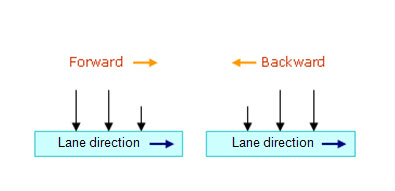Moving Load Optimization
Moving load optimization allows you to find the number of loaded lanes and the exact position of vehicles in the transverse direction as well as longitudinal direction, which will give the most critical responses.
Applicable code in Civil 2019 (v1.1): AASHTO Standard, AASHTO LRFD, PENNDOT, Canada, BS, Eurocode, Russia, Australia
Steps to follow for Moving Load Optimization:
1. Define required data here.
2. Define vehicles.
3. Go to the ‘Moving Load Case’ function and select the ‘Moving Load Optimization’ option.
From the Main Menu select Load > Moving Load > Traffic Surface Lanes > Moving Load Optimization.
![]()
To
enter new or additional traffic surface lanes
![]()
To modify previously entered traffic surface lanes
Select
a Lane Name for which lane information is to be modified.
![]()
To delete previously entered traffic surface lanes
Select
a Lane Name for which lane information is to be deleted.
![]()
To copy previously entered traffic surface lanes
Select a Lane Name for which lane information is to be copied.
 Lane Name
Lane Name
Enter the name of a traffic surface lane.
 Traffic Lane Properties
Traffic Lane Properties
Optimization Lane
Enter the carriageway width.
Lane Width
Enter the width of single design lane.
Generate Analysis Lanes
Number of Lanes (2^N+1)
N: A whole number to determine the number of lanes in the optimization lane.
Offset from Centerline
Transverse increment of the location of the vehicle centerline. To find the critical position of vehicles, the program will generate the centerlines of vehicles in the transverse direction within the carriageway width. The ‘Anal. Lane Offset’ parameter defines the spacing of the centerlines. The first centerline is generated at the centerline of carriageway width. The second centerline is generated away from the first centerline by the value of "Anal. Lane Offset" to the both left and right side. More centerlines will be generated for the whole carriageway width.

Vehicle centerlines which do not satisfy the requirements of margin and minimum spacing between vehicles will be removed from the vehicle application.
Wheel Spacing
Enter the transverse spacing between the wheels in an axle. For influence line analysis, the program automatically applies a load equal to "Load ÷ no. of wheels" to each wheel.
Margin
Minimum distance between a wheel load and boundary of a single lane. Margin should be so chosen that the sum of vehicle width and 2 times margin does not exceed the single lane width.

The minimum distance between vehicles is determined as the larger between ‘2 times margin’ and ‘Min. Vehicle Distance’ entered from the ‘Moving Load Case’ dialog.

![]() Offset Distance to Lane Center
Offset Distance to Lane Center
Enter the distance from the line of traffic lane nodes to the center
of the carriageway lane. Viewing towards the moving direction
of the traffic surface lane, a positive eccentricity (+) refers
to an offset to the right from the traffic lane nodes and a negative
eccentricity (-) refers to an offset to the left from the traffic
lane nodes.
Straddling Lane Type (BS and Eurocode only)
Check on this option to consider straddling of HB load, special vehicles and Load Model 3.
Impact Factor (AASHTO Standard only)
Enter the impact factors for the entered traffic line lane elements.
Skew: Specify the Skew Angles at the Start and End of the bridge.
 Moving
Direction
Moving
Direction
Assign the direction of traffic loads.
Forward: Consider the direction from the Start to End only.
Backward: Consider the direction from the End to Start only.
Both: Consider the both direction.

 Selection
by
Selection
by
![]() 2
Points: Beam elements
in a line defined by 2 points are assigned as traffic line lane
elements. The first point becomes the Start point.
2
Points: Beam elements
in a line defined by 2 points are assigned as traffic line lane
elements. The first point becomes the Start point.
![]() Picking
/ Number
Picking
/ Number
Select all the nodes along the traffic lane node line.
Use the mouse or directly enter the node numbers to create a traffic lane node line.
Note
The traffic surface lane is defined by the traffic lane node line,
eccentricity and traffic lane width. The traffic surface lane
is created by placing the traffic lane center offset by an eccentricity
distance from the traffic lane node line. Extending 1/2 of the
lane width on both sides of the lane center while looking towards
the moving direction defines the traffic surface lane.
![]() Operations
Operations
The data entry is reflected when Selection by Number is selected.
Add : Add selected nodes to the traffic lane node line.
Insert : Insert selected nodes to become a part of the previously entered traffic lane node line.
Delete : Delete selected nodes from the traffic lane node line.
![]() Span Start (AASHTO Standard, AASHTO LRFD, PENNDOT only)
Span Start (AASHTO Standard, AASHTO LRFD, PENNDOT only)
For multi-span bridges, select the starting element of each span to distinguish spans. This is used to calculate the maximum negative moment of a continuous bridge due to traffic loads.
Note
The Moving Load Optimization
feature supports following codes:
AASHTO Standard, AASHTO LRFD, Canada, BS, Eurocode and Poland
Standard.
Input Example:
